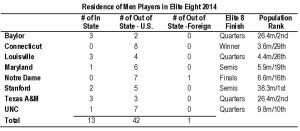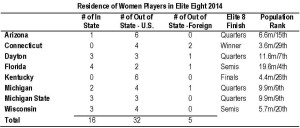This brief analysis evaluated rosters of men’s and women’s Elite Eight NCAA basketball teams to determine what states or countries their players reside in. It looked at information published on their athletic websites in March 2014. Players were included in the sample if their average playing time per game for the season was greater than 15 minutes. As well, this study looked at the population of the states where the universities are located to see if there might be a relationship between the size of the population and the number of in-state players.
The following tables list the schools, number of in-state players, out-of-state players, their finish in the Elite Eight, total state population, and rank of the state in terms of population.
The results for the men are in the table below.

The results for the women are in the table below.

Listed below are similarities and differences between the men’s and women’s programs.
Similarities
- The men and women players come from a similar number of states, 20 for the men and 19 for the women.
- None of the top players for the mens’ and womens’ championship teams were from in-state.
- Teams from larger states tend to have more in-state players.
- A majority of the players on most teams are from out-of-state.
- The reliance on foreign players is minimal; it is slightly higher for the men than the women.
- The foreign country with the highest number of players in Canada.
- The programs with a higher percentage of in-state players are less “successful” (this is not necessarily a cause and effect relationship).
- The schools from states with smaller populations typically have fewer in-state players and are less “successful”.
Differences
- The percentage of out-of-state U.S. players is greater for women than men, 75.0% vs. 60.4%.
- The percentage of in-state players is greater for the men than women, 30.2% vs. 23.2%.
- The states with the highest number of players for the men are Michigan and Ohio. For the women, the top states are Texas, New York, and Pennsylvania.
For more details see Residence of Top Players 2014 NCAA Elite Eight Basketball Teams. This report identifies the home state or country of the top PAC 12 basketball players and compares differences between the men and women teams.



